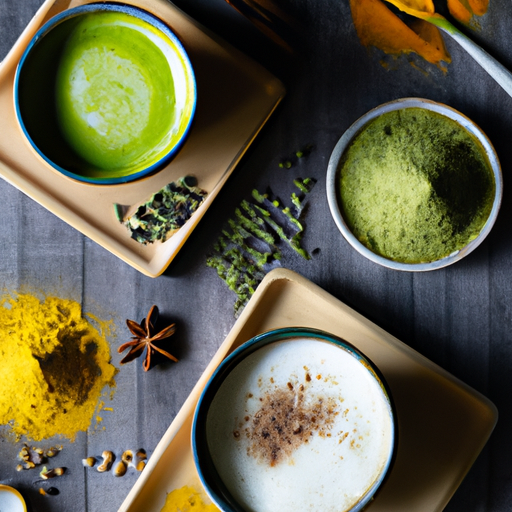Step into the vibrant world of spices and greens, where golden hues and vibrant emerald collide. Like a culinary tango, turmeric and matcha dance gracefully, each boasting their own set of health benefits and unique flavors.
But which one reigns supreme? In this article, we will explore the battle of the superfoods: turmeric versus matcha.
Turmeric, the golden spice of the East, has been revered for centuries for its medicinal properties. Its active compound, curcumin, is believed to possess anti-inflammatory and antioxidant effects.
On the other hand, matcha, the powdered green tea from Japan, is celebrated for its high concentration of catechins, which are potent antioxidants.
Join me as we delve into the depths of their nutritional profiles, discover their culinary versatility, and unravel any potential considerations or side effects.
By the end of this journey, you will be equipped with the knowledge to make an informed choice: turmeric or matcha? So, grab your mug or spice jar, and let’s embark on this flavorful expedition together.
Key Takeaways
- Turmeric contains curcumin, which has anti-inflammatory and antioxidant effects, while matcha is high in catechins, which are potent antioxidants.
- Turmeric supports joint health, reduces inflammation, and improves digestion, while matcha aids in weight loss by boosting metabolism and increasing fat oxidation.
- Turmeric boosts immunity, promotes healthy digestion, and provides antioxidant support, while matcha provides sustained energy without jitters or crashes and improves focus and concentration.
- Turmeric can be added to various dishes like scrambled eggs, roasted vegetables, and sauces/dressings, while matcha is used in beverages, desserts, and savory dishes.
Health Benefits of Turmeric
Turmeric’s amazing health benefits make it a must-have in my daily routine. This vibrant yellow spice has been used for centuries in Ayurvedic medicine and is known for its powerful anti-inflammatory properties.
One of the most popular ways to consume turmeric is through turmeric supplements, which provide a concentrated dose of the spice. These supplements are believed to support joint health, reduce inflammation, and improve digestion.
Another way to enjoy the benefits of turmeric is by drinking turmeric tea. This soothing beverage is made by steeping grated turmeric root or turmeric powder in hot water. Turmeric tea is known to boost immunity, promote healthy digestion, and provide antioxidant support.
Additionally, studies have shown that turmeric may have potential benefits for brain health and may help alleviate symptoms of depression and anxiety.
As we transition to the next section about the health benefits of matcha, it’s important to note that while turmeric offers a wide range of benefits, matcha also has its own unique set of health-promoting properties.
Health Benefits of Matcha
In a world of vibrant greens, matcha emerges as a powerful elixir, nurturing the body with its wealth of health benefits. One of the most notable benefits of matcha is its potential for aiding in weight loss. Matcha contains a compound called EGCG, which has been shown to boost metabolism and increase fat oxidation.
Additionally, matcha provides a sustained energy boost without the jitters or crash associated with other caffeinated beverages. This can help promote physical activity and calorie burning, ultimately supporting weight loss goals.
Matcha is also known for its ability to improve focus and concentration. It contains a unique combination of caffeine and L-theanine, an amino acid that promotes relaxation and mental clarity. This combination enhances cognitive function and helps to keep the mind alert and focused. Many people find that incorporating matcha into their daily routine improves their productivity and mental performance.
In the subsequent section about nutritional comparison, we’ll explore how matcha stacks up against turmeric in terms of their nutritional profiles and overall health benefits.
Nutritional Comparison
Boost your nutritional intake by comparing the nutritional profiles of matcha and turmeric. Matcha is known for its high antioxidant content, while turmeric is celebrated for its anti-inflammatory properties. Let’s take a closer look at the nutritional comparison between these two powerhouse ingredients.
| Nutrient | Matcha | Turmeric |
|---|---|---|
| Calories | 4 | 24 |
| Protein | 0.4g | 0.5g |
| Fat | 0.2g | 0.7g |
| Carbohydrates | 0.6g | 4.4g |
| Fiber | 0.5g | 1.4g |
As we can see, matcha is lower in calories, fat, and carbohydrates compared to turmeric. However, turmeric contains slightly more protein and fiber. Both ingredients offer unique nutritional benefits, making them valuable additions to a healthy diet.
When it comes to versatility in recipes, matcha is often used in beverages, desserts, and even savory dishes like matcha-infused noodles. Turmeric, on the other hand, is commonly used in curries, soups, and rice dishes.
Interestingly, turmeric and matcha can be used together in a recipe, combining their respective health benefits. For example, you can create a delicious matcha turmeric latte by blending matcha powder with turmeric, almond milk, and a touch of sweetener.
Transitioning into the next section about the culinary uses of turmeric, we will explore the various ways this vibrant spice can elevate your dishes.
Culinary Uses of Turmeric
Step up your culinary game and discover the endless possibilities of incorporating the vibrant spice of turmeric into your recipes.
Turmeric has been a staple in Indian cuisine for centuries, adding a distinct flavor and rich golden color to dishes. From curries and stews to rice and lentil dishes, this versatile spice can elevate any meal.
Not only does turmeric enhance the taste of your dishes, but it also offers numerous health benefits. Its active compound, curcumin, has been shown to have anti-inflammatory and antioxidant properties, which can help reduce the risk of chronic diseases. Additionally, turmeric has been used in traditional beauty products for its potential skin-enhancing properties. It’s believed to promote a healthy complexion and may help reduce the appearance of blemishes and acne.
Incorporating turmeric into your culinary creations is easy. Here are three ways to use turmeric in your cooking:
- Add a pinch of turmeric to your scrambled eggs or omelets for a vibrant yellow hue.
- Use turmeric as a seasoning for roasted vegetables, giving them a flavorful twist.
- Experiment with turmeric-infused sauces or dressings to add a unique flavor profile to your salads or grain bowls.
With its versatility and health benefits, turmeric is a must-have ingredient in any kitchen.
Now, let’s explore the culinary uses of matcha.
Culinary Uses of Matcha
When it comes to culinary uses, matcha has a rich history in Japanese tea ceremonies. This vibrant green powdered tea has been traditionally used in these ceremonies for centuries, where it’s whisked with hot water to create a frothy beverage.
Nowadays, matcha has also gained popularity in baking and desserts, bringing its unique flavor and color to cakes, cookies, and ice creams. Additionally, matcha-infused drinks and smoothies have become increasingly popular, offering a refreshing and energizing way to enjoy this versatile ingredient.
Traditional use in Japanese tea ceremonies
Imagine yourself sitting in a serene Japanese tea ceremony, where the vibrant green matcha takes center stage, inviting you into a world of tranquility and tradition. Japanese tea ceremonies have a rich history and hold great significance in Japanese culture. They are elaborate rituals that symbolize harmony, respect, and tranquility.
During these ceremonies, matcha is prepared and served using special utensils, such as a bamboo whisk, a tea scoop, and a ceramic bowl. The process is meticulous and precise, with every movement carefully choreographed. The tea is whisked into a frothy, velvety texture, creating a sensory experience that is both calming and invigorating.
To give you a glimpse into the captivating world of Japanese tea ceremonies, here is a table showcasing some of the traditional utensils used:
| Utensil | Description |
|---|---|
| Chasen (Bamboo Whisk) | Used to whisk the matcha powder and hot water together. |
| Chashaku (Tea Scoop) | Used to measure and transfer the matcha powder into the bowl. |
| Chawan (Ceramic Bowl) | Specially crafted bowl used for whisking and drinking matcha. |
| Chakin (Tea Cloth) | Used to wipe the bowl and utensils clean. |
The traditional use of matcha in Japanese tea ceremonies is just one way this versatile ingredient is enjoyed. In the next section, we will explore its role in baking and desserts.
Matcha in baking and desserts
Indulge in the luscious world of matcha-infused pastries and desserts, where each bite transports you to a blissful state of culinary delight.
Matcha, the vibrant green powdered tea, has found its way into various baking recipes, adding a unique and earthy flavor. One popular way to incorporate matcha in desserts is by using it in ice cream. The subtle bitterness of matcha balances perfectly with the creaminess of ice cream, creating a refreshing and indulgent treat.
Additionally, matcha can also be used in cocktails, adding a delightful twist to traditional mixed drinks. Its bold and distinctive flavor profile adds complexity and depth to the cocktail experience.
As we delve into the world of matcha-infused drinks and smoothies, get ready to explore a whole new level of culinary creativity.
Matcha-infused drinks and smoothies
Get ready to elevate your taste buds with matcha-infused drinks and smoothies, as they’ll take you on a flavorful journey like no other. Matcha, with its vibrant green color and earthy taste, can be the perfect addition to your favorite beverages. Here are a few ways you can enjoy matcha-infused drinks and smoothies:
-
Matcha-infused cocktails: Mix matcha powder with your favorite spirits or liqueurs to create unique and refreshing cocktails. The combination of the rich flavors of matcha with the subtle sweetness of the alcohol creates a delightful balance.
-
Matcha-infused skincare products: Matcha is not only delicious but also beneficial for your skin. Incorporating matcha powder into skincare products like face masks or scrubs can help detoxify and rejuvenate your skin, leaving it feeling refreshed and glowing.
-
Matcha-infused smoothies: Blend matcha powder with fruits, yogurt, and milk for a refreshing and energizing smoothie. The antioxidants present in matcha can provide an added boost to your morning routine.
Considering the various ways you can enjoy matcha-infused drinks and smoothies, it’s important to also be aware of any potential considerations and side effects.
Considerations and Side Effects
When it comes to considerations and side effects, you’ll want to know that both turmeric and matcha have their own unique properties and potential benefits for your well-being.
Turmeric is generally considered safe when consumed in moderate amounts as part of a balanced diet. However, some people may experience side effects such as stomach upset, dizziness, or diarrhea when taking high doses or using turmeric supplements for an extended period. It’s always advisable to consult with a healthcare professional before starting any new supplement regimen.
Similarly, matcha is generally safe for most people when consumed in moderation. However, it does contain caffeine, so individuals who are sensitive to caffeine should be cautious. Excessive consumption of matcha can lead to side effects such as insomnia, increased heart rate, or digestive issues. Additionally, matcha may interact with certain medications, so it’s important to consult with a healthcare provider if you have any underlying health conditions or are taking medication.
Considering these potential side effects and individual sensitivities, it is important to follow dosage recommendations and listen to your body’s response when incorporating turmeric or matcha into your routine.
Now that we have explored the considerations and side effects of both turmeric and matcha, let’s move on to the next section to make an informed choice between the two.
Making a Choice: Turmeric or Matcha?
In the decision-making process between turmeric or matcha, it’s like choosing between a vibrant sunrise or a warm sunset. Both turmeric and matcha offer unique benefits and have their own cultural significance. When it comes to versatility, turmeric takes the lead. Its distinct flavor and vibrant yellow color make it a popular addition to curries, soups, and even smoothies. Matcha, on the other hand, is primarily used in Japanese tea ceremonies and as a base for delicious green tea lattes.
Let’s explore the cultural significance of both turmeric and matcha. Turmeric has been used for centuries in Ayurvedic medicine and is deeply rooted in Indian culture. It is often associated with purification rituals and is a common ingredient in traditional Indian dishes. Matcha, on the other hand, is an integral part of Japanese tea ceremonies, where it is prepared and served with great care and precision.
To help you make an informed choice, let’s compare the versatility of turmeric and matcha in a table:
| Turmeric | Matcha |
|---|---|
| Used as a spice and coloring agent in various cuisines | Primarily used in Japanese tea ceremonies |
| Offers potential health benefits, such as anti-inflammatory properties | Contains antioxidants and provides a calming effect |
| Can be consumed in various forms: fresh, dried, powdered | Comes in powdered form and can be used in baking and cooking |
Both turmeric and matcha have their own unique qualities and cultural significance. Whether you choose turmeric for its versatility in cooking or matcha for its ceremonial importance, incorporating either of them into your routine can add a touch of vibrancy and wellness to your life.
Frequently Asked Questions
Can turmeric or matcha help with weight loss?
Both turmeric and matcha have potential health benefits, but when it comes to weight loss, neither have strong evidence. Turmeric may help with inflammation, while matcha can provide an energy boost.
Are there any potential interactions between turmeric or matcha and medications?
There are potential side effects of turmeric or matcha when taken with certain medications. It is important to consult with a healthcare professional to determine if there are any interactions between these substances and your medications.
Can turmeric or matcha be used as a natural remedy for arthritis?
Turmeric’s anti-inflammatory properties and matcha’s antioxidant benefits make them potential natural remedies for arthritis. Studies suggest they may help reduce inflammation and oxidative stress, providing relief for some individuals. However, further research is needed to confirm their effectiveness.
Is it safe to consume turmeric or matcha during pregnancy or while breastfeeding?
During pregnancy, it is generally safe to consume turmeric in moderate amounts, but it’s best to consult with your healthcare provider first. Matcha is also considered safe while breastfeeding, but again, it’s important to seek professional advice.
Are there any specific guidelines for the dosage and consumption of turmeric or matcha for maximum benefits?
For maximum benefits, it’s important to follow dosage guidelines for turmeric and matcha. Turmeric has been linked to reducing inflammation and improving brain health, while matcha is rich in antioxidants and boosts metabolism.
Conclusion
After examining the health benefits, nutritional values, and culinary uses of both turmeric and matcha, it’s clear that both have their own unique advantages.
Turmeric offers anti-inflammatory properties and aids digestion.
Matcha provides a boost of antioxidants and promotes relaxation.
Choosing between the two ultimately depends on individual needs and preferences.
Like two sides of a coin, turmeric and matcha each have their own distinct qualities, offering a diverse range of benefits to enhance our well-being.










